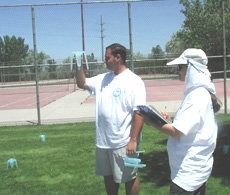Salt Lake City Green Spaces
City parks, golf courses and other green spaces get water checkup. You can have the same service by calling 877-728-3420 for a free water check
|
The City Council in their 2000-2001 “Legislative Intents” requested a study to determine the feasibility of a secondary water system as a means of reducing demand on the City’s municipal water supply. The Departments of Public Utilities and Public Services teamed together to conduct the study. Public Services is responsible for the City’s green spaces. Stantec Consulting Inc. was awarded the contract with the following scope of work: Determine the feasibility and planning evaluation of 1) existing irrigation of City owned open space, 2) secondary water system and source development and 3) landscape requirements for new development.
Salt Lake City owns and maintains a wide range of properties and is the single largest water user on its municipally owned water system. As part of the study, the consultant inventoried 1,400 acres of green space and determined the efficiency of the irrigation systems. Included in the study were the all City owned properties including the International Airport, parks, golf courses and other public green spaces.
The study estimates that water usage on the 611 acres of city parks could be reduced by 214 acre-feet a year. Likewise, the City’s 8 golf courses with 841 acres of irrigated turf could reduce water use as much as 423 acre feet of water. The overall water saving would be about 21 percent.
In the spring of 2002 it was decided to go beyond inventorying the City’s green space and conduct the necessary water checks to actually determine the water efficiency of each system of each park and golf course. Four water check technicians were hired specifically for this purpose. The goal is to have all of the City’s green space checked this summer. The data will help set capital improvement priorities, determine cost estimates and provide the mechanism for establishing a budget and schedule in which to improve watering efficiencies. The water check teams are also identifying and cataloging items for immediate repair, so the water savings have already begun.
According to public utilities engineer, Tom Ward, “The study and final report is intended as a planning resource for development, funding and implementation of operational and capital improvements needed to achieve the City’s increased water conservation and efficiency goals.”
The water check program has been in place since 1994 and the data collected from both residential and commercial landscapes indicate that lawns are over watered. According to a report written by Utah State Extension Services Salt Lake County Agent Earl Jackson, water checks have found that lawns are over watered by 30-40 percent. A properly designed irrigation system with conscientious operation can save water and still provide a healthy landscape.
Anyone can have a water check free of charge, by calling 877-728-3420 and for information on how to conserve water visit our web site at www.slcsaveh2o.com.
